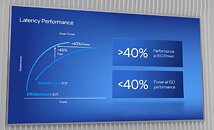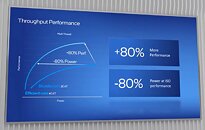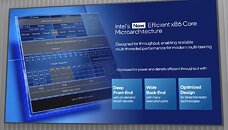- Joined
- Oct 9, 2007
- Messages
- 47,577 (7.46/day)
- Location
- Dublin, Ireland
| System Name | RBMK-1000 |
|---|---|
| Processor | AMD Ryzen 7 5700G |
| Motherboard | ASUS ROG Strix B450-E Gaming |
| Cooling | DeepCool Gammax L240 V2 |
| Memory | 2x 8GB G.Skill Sniper X |
| Video Card(s) | Palit GeForce RTX 2080 SUPER GameRock |
| Storage | Western Digital Black NVMe 512GB |
| Display(s) | BenQ 1440p 60 Hz 27-inch |
| Case | Corsair Carbide 100R |
| Audio Device(s) | ASUS SupremeFX S1220A |
| Power Supply | Cooler Master MWE Gold 650W |
| Mouse | ASUS ROG Strix Impact |
| Keyboard | Gamdias Hermes E2 |
| Software | Windows 11 Pro |
When early benchmarks of the Core i9-12900K "Alder Lake-S" processor showing performance comparable to AMD's top 16-core Ryzen 9 5950X surfaced, we knew something was up. 8 Intel P-cores and 8 E-cores, are able to match 16 "Zen 3" cores that are all performance cores. Apparently Intel is able to turn its P-core deficit around by taking a wacky approach. First, the 8 "Golden Cove" P-cores themselves offer significantly higher IPC than "Zen 3." Second, the 8 "Gracemont" E-cores aren't as "slow" as conventional wisdom would suggest.
Intel in its Architecture Day presentation put out some astounding numbers that help support how 8 big + 8 little cores are able to perform in the league of 16 AMD big cores. Apparently, on "Alder Lake-S," the 8 "Gracemont" E-cores enjoy a lavish power budget, and are able to strike an incredible performance/Watt sweet-spot. Intel claims that the "Gracemont" E-core offers 40% higher performance at ISO power than a "Skylake" core (Intel's workhorse P-core for desktops until as recently as 2020); which means it consumes 40% less power at comparable performance.



A "Gracemont" core hence doesn't end up too far behind "Skylake." The combination of high-IPC P-cores and "fairly fast" E-cores are hence able to attain performance levels comparable to 16 "Zen 3" cores. There are some limitations, though. For starters, "Gracemont" cores don't support HyperThreading, unlike "Skylake," and have a reduced ISA instruction-set compared to the P-cores.
View at TechPowerUp Main Site
Intel in its Architecture Day presentation put out some astounding numbers that help support how 8 big + 8 little cores are able to perform in the league of 16 AMD big cores. Apparently, on "Alder Lake-S," the 8 "Gracemont" E-cores enjoy a lavish power budget, and are able to strike an incredible performance/Watt sweet-spot. Intel claims that the "Gracemont" E-core offers 40% higher performance at ISO power than a "Skylake" core (Intel's workhorse P-core for desktops until as recently as 2020); which means it consumes 40% less power at comparable performance.



A "Gracemont" core hence doesn't end up too far behind "Skylake." The combination of high-IPC P-cores and "fairly fast" E-cores are hence able to attain performance levels comparable to 16 "Zen 3" cores. There are some limitations, though. For starters, "Gracemont" cores don't support HyperThreading, unlike "Skylake," and have a reduced ISA instruction-set compared to the P-cores.
View at TechPowerUp Main Site


 Its interesting nonetheless.
Its interesting nonetheless.

